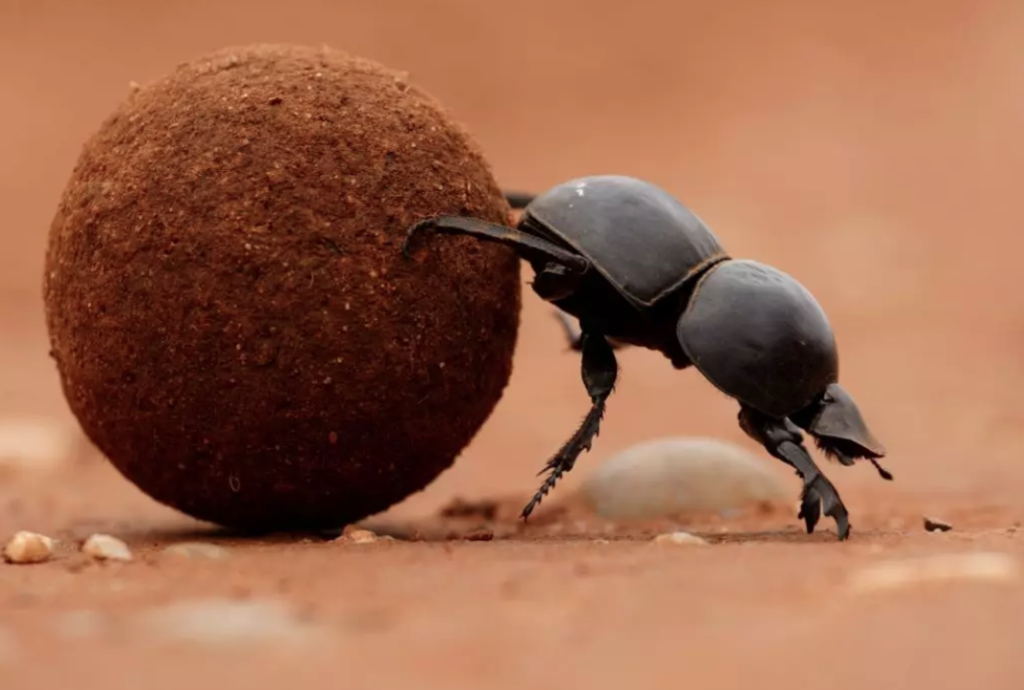Dung Beetles: Crappy Celestial Travelers
In this episode, we explore the bizarre fact that – like Galileo himself – African Dung Beetles use the stars to navigate! As a bonus, we talk with Eric Warrant, Professor of Biology at Lund University and co-author of the ground-breaking discovery.

There are 3 main types of Dung Beetles. The difference is how they like their food. The main kind we think of is the beetle rolling the giant ball of dung. That’s the kind we’ll be talking about in this episode. But there are also Dung Beetles who tunnel through giant piles of poop and eat it that way. And then some of them just live inside poop. There’s a saying, never eat where you poop. But for dung beetles, it’s okay because its not their poop.
Something crazy about Dung Beetles. In a way, they’re the world’s strongest animal. Relative to their weight, they can lift more than any other animal. How much more? Get this. This is crazy. When they’re rolling a ball of dung, a dung beetle can pull 1,141 times its own bodyweight. So imagine a 200 pound man lifting 228,200 lbs. That’s like one man lifting a blue whale – the largest mammal to have ever lived. For reference, the entire space shuttle weighs 160,000 lbs. So now imagine a 200 lbs man on a runway pushing the space shuttle all by himself. And not even an empty space shuttle. In the payload bay of the shuttle, is the anchor of a cruise ship. That’s what we’re talking about here. Dung beetles are on average about the size of a gummy bear. Absolutely crazy. One of the things they use that immense body strength for is – for males anyway – fighting with other males. The male dung beetles lock horns and fight for female attention and for dung. So again – back to our example of comparing that to a human. That’s two dudes fighting each other, each with the power to lift a BLUE WHALE by himself.
So WHY do they roll the ball of dung, you may be wondering. Here’s the deal. When an animal lays a fresh steaming pile, the dung beetles come in. The don’t use their noses to smell poop like we do. They use their antennae. They have special poop-antennae on their head that’s specialized for the scent of fresh animal droppings. They spend most of their time on the ground, but they can fly – sometimes up to several miles for a good pile of dook. They eat the dung of herbivores, and herbivores suck at completely digesting their food. SO – there tend to be a lot of nutrients leftover that are partially-digested. Grass, liquid, and it’s this nutrient-rich poop liquid that the dung beetles like. They eat it, and they lay eggs in it so their babies can have food. So these beetles crawl in to the pile, start rolling up some fresh dung and then getting it away. They want to get it away because they want to get it to a spot where they can save it for themselves and their eggs and so they’re not fighting with other beetles for it. They roll it and the females lay eggs in it and they bury it – that keeps a safe food source for them later and there are some added consequences like it loosens up the soil which nourishes the land and helps control fly populations.
Just like most insects, their movements are motivated by a couple things. Mating and eating. When it comes to the subject of this episode, we’re talking about their movement as it involves them rolling the dung ball. A couple things to know: 1) The roll the ball in a straight line, and 2) they need to remember where the ball is that they’ve buried. This is where navigation comes in.
National Geographic journalist Christine Dell’Amore wrote a piece in 2013 with this title, “Dung Beetles Navigate Via the Milky Way, First Known in Animal Kingdom.” In the piece, she cites to work of a Biologist from Lund University in Sweden, Eric Warrant. Warrant co-authored a study that figured out this crazy fact. Scientists knew that the beetles rolled in a straight line, and it was important that they were rolling it away from the pile, but they didn’t know how the beetles were doing it. One of the best guesses leading up to this study was that they were navigating at night using the position of the moon. But then they saw that the beetles were able to still do so on moonless nights. Eric Warrant said this caused scientists a lot of grief. So they conducted a study.

Here’s what they found out. Dung Beetles, it turns out, can see the Milky Way, which from Earth, creates sort of an oblong skinny oval. That oval points a particular direction, and that is what the Beetles use to navigate. Usually the human eye can’t see the Milky Way, but dung beetles have this ability with super sensitive eyeballs. They use that faraway point much like sailors use the stars to navigate. The idea of celestial navigation is simple, really. Stars are really far away, so picking a point that doesn’t move (or barely, imperatively moves), you can be sure you’re following a straight line. For sailors, they have to know where certain stars appear in the night sky so they can orient themselves to North, South, East and West. For dung beetles, this doesn’t matter the important part is that they are moving in a straight line AWAY from the pile. And then using that straight line, they know their way back to the pile.
So YES. Now you know something crazy. Dung Beetles are the first insects discovered to use celestial navigation.
Here’s my conversation with Eric Warrant:
To see bonus content like unedited videos of these interviews, check out our Patreon at http://Patreon.com/michaelkent
For special discounts, visit http://theinternetsaysitstrue.com/deals
Podcast: Play in new window | Download


